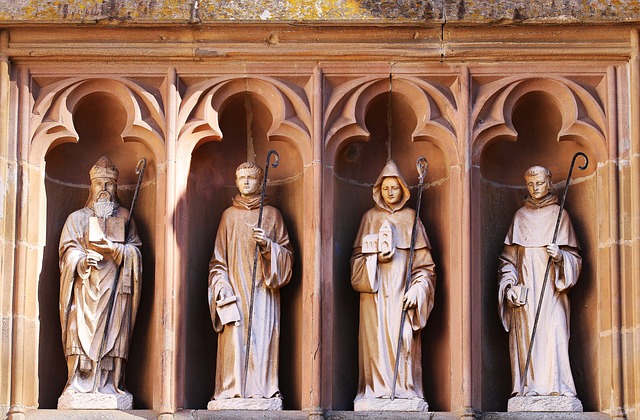In the heartland of Europe resides a country that holds within its borders a secret concoction of divine delights: Belgium. Nestled between the canals of Bruges and the towering spires of Brussels lies a peculiar cultural phenomenon that has captivated the world for centuries – the art of Belgian beer brewing. From the humble chambers of monastic abbeys to the bustling beer cafes adorning quaint streets, Belgium’s beer culture is a tapestry woven with passion, tradition, and a touch of sacred mystique. Unraveling the secrets behind this liquid gold and unmasking the role of Trappist monks in its creation will take us on an enchanting journey into the heart of a nation that reveres beer as a cherished work of art. So, grab a chalice, dear reader, and join us as we delve deep into the fascinating realm of Trappist Monks and Beers: Understanding Belgium’s Beer Culture.
Trappist Monks and Beers: A Divine Brewing Tradition
Belgium, a country famous for its medieval cities and mouthwatering chocolates, is also home to a centuries-old brewing tradition: Trappist beers. These divine beverages, meticulously crafted by Trappist monks in their monastic breweries, offer a unique glimpse into Belgium’s rich beer culture.
The origins of Trappist brewing can be traced back to the contemplative lifestyle of the monks, who dedicate their lives to prayer, work, and simplicity. These devoted individuals, residing within the walls of picturesque abbeys, have been brewing beer as early as the 17th century. Today, the Trappist order strictly regulates the production and sale of these sacred brews under a worldwide trademark ensuring their authenticity and dedication to monastic traditions.
- Trappist beers are brewed within the walls of a Trappist monastery, adhering to strict guidelines set by the International Trappist Association.
- There are currently only 12 Trappist breweries worldwide, and six of them are located in Belgium.
- Each Trappist beer has a unique character, offering a wide range of flavors from strong ales to delicate blondes and rich quadrupels.
- Trappist breweries support the financial sustainability of monastic life, with profits primarily used for the upkeep of the monastery and the surrounding community.
These divine brews represent more than just exquisite beverages. They symbolize a connection to centuries of contemplation, discipline, and craftsmanship. Exploring Belgium’s Trappist beers is not only an indulgence for the taste buds, but a journey through the profound history of monastic life.

Exploring Belgium’s Rich Beer Heritage
Belgium, a country known for its exquisite chocolate and stunning architecture, also boasts a rich beer heritage that is not to be overlooked. One cannot truly understand Belgium’s beer culture without diving into the fascinating realm of Trappist monks and their dedication to brewing. These holy men have been perfecting their craft within the walls of monasteries for centuries, a tradition that has become synonymous with excellence and divine flavors.
When it comes to Trappist beers, there is a distinct sense of authenticity and passion that permeates every bottle. Brewed by monks who adhere to strict religious principles and follow meticulous brewing techniques, these beers are truly a labor of love. The Trappist monasteries, such as Westvleteren, Chimay, and Orval, produce a limited quantity of beer using traditional recipes passed down through generations. Each sip reveals complex flavors that can only be achieved through years of dedicated craftsmanship and attention to detail.
Belgium’s beer heritage extends far beyond the realm of Trappist brewing, however. With over 1,500 beers to choose from, the country offers a diverse range of styles and flavors that cater to every palate. From refreshing wheat beers to robust and velvety dark ales, there is something to suit every beer lover’s taste. Belgian brewers are known for their innovative approach to beer-making, often incorporating unique ingredients like spices, fruit, and even chocolate into their creations. This experimentation has led to the development of extraordinary brews that push the boundaries of what beer can be.
Belgium’s beer culture is a melting pot of tradition, innovation, and undeniable craftsmanship. Whether you’re sipping on a Trappist masterpiece or exploring the vast array of Belgian beer styles, each glass tells a story of centuries-old traditions and a passion for brewing that has stood the test of time. So, raise your glass and toast to the proud heritage of Belgian beer – a liquid art form that continues to captivate beer enthusiasts around the world.
Unraveling the Secrets of Trappist Brews
Belgium, a country known for its rich culinary traditions, is also home to a centuries-old beer culture that is deeply intertwined with the country’s monastic history. Among the many fascinating aspects of Belgium’s beer scene, one of the most intriguing secrets lies hidden within the walls of Trappist monasteries. These sacred sites are not only havens of contemplation and devotion but also birthplaces of some of the world’s most sought-after brews.
Trappist beers, brewed exclusively by Trappist monks, are a testament to their dedication, craftsmanship, and unwavering commitment to quality. Behind closed doors, these monks carefully brew their beers using traditional methods passed down through generations. The recipes themselves are closely guarded secrets, often protected by monastic vows and only known to a select few within the community.
- Each Trappist monastery typically produces a limited variety of beers, focusing on perfecting a small range of exceptional brews.
- These monks follow a slow and patient brewing process, allowing their beers to ferment and mature naturally for extended periods.
- The use of high-quality, locally sourced ingredients, including unique yeast strains developed and maintained by the monasteries, adds distinctive flavors to their brews.
Trappist beers are renowned for their complexity, depth, and unparalleled taste experiences. They are often characterized by rich maltiness, fruity esters, spicy notes, and a delightful balance between bitterness and sweetness. From the iconic Westvleteren to the world-famous Orval, each Trappist beer tells a unique story of the monastic traditions and the dedication poured into every bottle.

Must-Try Trappist Beers: Recommendations for Novices and Connoisseurs
Belgium is home to a centuries-old brewing tradition that has been perfected by Trappist monks. These devoted men of God have embraced the art of brewing to sustain their monasteries and preserve their way of life. The result? A remarkable range of Trappist beers that have captivated the taste buds of novices and connoisseurs alike.
For novices who are just dipping their toes into the world of Trappist beers, we recommend starting with the renowned Chimay triple. This golden-hued ale with a heavenly balance of fruity and spicy notes is a great introductory choice. If you prefer a darker brew, the Westmalle Dubbel offers a rich mahogany color, toasted malt flavors, and a hint of caramel. Another beginner-friendly option is the Orval, a Trappist beer with a unique tangy character derived from its distinctive Brettanomyces yeast strain.
For the connoisseurs seeking a more complex and intense experience, venture into the world of Rochefort 10. This extraordinary beer boasts a deep mahogany color, a velvety texture, and a bold, complex flavor profile with notes of dark fruit, chocolate, and spice. If you’re up for a challenge, the Westvleteren 12 is often hailed as the “best beer in the world.” It’s a rare gem to be savored, with its deep brown appearance, rich flavors of caramel, toffee, and dark fruits, and a hint of warming alcohol. The La Trappe Quadrupel, an intensely malty and robust beer, is another sensational choice for the seasoned drinker.
Bold, nuanced, and steeped in centuries of Trappist brewing tradition, these beers allow you to embark on a captivating journey through Belgium’s rich beer culture. Whether you’re a novice seeking a taste of divine craftsmanship or a connoisseur in pursuit of new flavors, these Trappist beers are a must-try for every beer lover.
Final Thoughts
As we delve into the enchanting world of Trappist monks and beers, we come to realize that Belgium’s beer culture is an exquisitely woven tapestry, blending centuries-old traditions with an unwavering dedication to craftsmanship. The iconic monasteries scattered across the picturesque landscapes serve as epicenters, where these monks silently pour their devotion into every sip we take.
Belgium’s famous brews, bathed in a golden hue, have transcended their existence as mere beverages. They have become symbols of an entire nation, resonating with history, community, and a love for the art of brewing. Each bottle holds the untold tales of monks toiling away in monastic silence, translating their spiritual devotion into liquid gold.
These ancient monastic traditions, passed down through generations, have birthed a unique approach to brewing that emphasizes purity, simplicity, and absolute dedication. The monks strive for the perfect balance of flavors, crafted with painstaking attention to detail. As they honor their vows of silence, they let the beers speak for themselves, beckoning us to experience a taste that evokes a heavenly connection.
Beyond the frothy allure of Belgium’s beers lies a culture rooted in reverence, humility, and a profound respect for nature’s gifts. Monks cultivate their own yeasts, harvest their ingredients diligently, and often hold the secrets to recipes that date back centuries. The result is a harmonious dance between the sacred and the mundane, encapsulated within each sip.
This article has mere glimpses into a vast world – a world where brewing is an intricate ballet, performed by monks who have devoted their lives to honing their craft. It is a testament to the power of passion, heritage, and a quiet determination to preserve tradition amidst a rapidly shifting world.
So, next time you raise a glass of Belgium’s fine beer, take a moment to savor not only the vibrant flavors but the rich tapestry of stories that accompany every bottle. Remember the silent monks who, with each sip, share their centuries-old wisdom, inviting us to toast to a culture cultivated with love, reverence, and an unyielding commitment to perfection.

